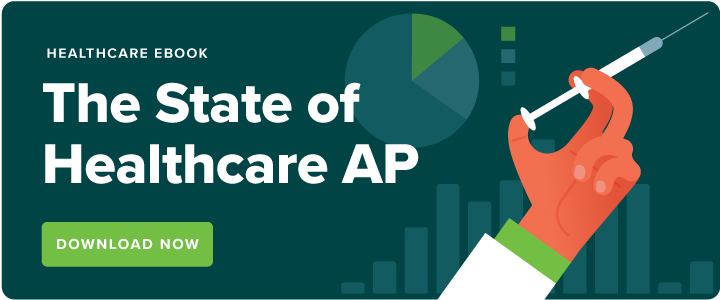Last month MineralTree published the findings from its 7th annual State of AP report, analyzing survey responses from over 1,200 finance professionals and suppliers. For the first time ever, the report features data from both AP teams and their suppliers – compiling answers from both groups to share their feedback regarding top priorities, challenges, and more.

This report data also provides an exciting opportunity to break down the state of AP across individual industries, so today we’re diving into the world of healthcare. Keep reading to learn more about its biggest AP challenges this year, key AP automation trends, and important stats to note as you begin planning for 2023.
Top 6 AP Challenges Facing Healthcare Organizations
Most organizations today must combat the business effects of the COVID-19 pandemic, hiring challenges, and supply chain disruptions. Beyond these headline-worthy priorities, this year’s State of AP survey data revealed that the majority of healthcare organizations face the same AP challenges. Here are the most common causes for invoice and payment processing delays in healthcare AP:
1. Manual processes are bogging down operations
Despite the fact that AP is the #1 back-office digitization priority amongst healthcare organizations for 2022, only 18.4% of those teams have fully automated their AP processes.
That means that over 80% of healthcare organizations still rely on manual AP processes, resulting in a time-consuming, costly, and error-prone system that can cause delays, late fees, and even penalties from suppliers. Ardent Partners’ ePayables Technology Adoption in 2022 research found that it costs organizations 40-90% more to manually process invoices than automating it. This added expense is especially problematic for healthcare organizations like outpatient treatment centers or veterinary consolidators that operate under thinner margins than organizations in other industries.
2. Deep reliance on checks
In a similar vein, manual check processing is costly and time-consuming for AP teams and can cause unnecessary problems and delays. Despite these drawbacks, most healthcare AP teams still rely on checks to a much greater degree than organizations in other industries. In fact, as of earlier this year, 42.4% of healthcare AP teams still issue more than half of their payments by check, compared to only 31% of their counterparts. In order to save time and money, healthcare organizations must be willing to move more of their payment mix away from checks.
3. New work models
As we’ve seen in the previous two points, healthcare AP teams generally tend to adopt new methods or embrace AP trends slower than other industries. That is, with the exception of their work models. This year, 64% of healthcare AP teams work in a remote or hybrid model (and professionals anticipate this group to grow to 69% next year) – right on track with other industries.
In addition to the industry’s impressive resilience during the COVID-19 pandemic, this shift in work environments demonstrates the industry’s ability to pivot towards new methods. Unfortunately, most manual AP processes are untenable with remote and hybrid models – causing increasing challenges for teams without AP automation. In order to stay afloat, AP teams in healthcare must find ways to streamline their AP workflow for remote and hybrid team members.
4. Higher invoice volume
On average, healthcare AP teams process a greater volume of monthly invoices and payments than respondents from other industries. In this year’s State of AP report, the number of healthcare AP teams processing more than 2,000 payments per month (12.7%) is double that of other organizations (6.1%), greatly increasing their workload.
This higher invoice volume forces lean AP teams to manage and organize more documents, route additional invoices for review and payment authorization, as well as respond to more vendor inquiries. With more invoices, suppliers, and inquiries to track, healthcare organizations have an immediate need for an AP automation tool to streamline their end-to-end accounts payable and document management processes.
5. Major staffing issues
Higher invoice volumes have historically prompted teams to add AP headcount, but the “great resignation” has recently made his approach unreliable for finance teams. This year, more than half (56%) of healthcare facilities that are planning to hire AP staff expect/strongly expect challenges and delays – and there’s no telling when this competitive hiring market will let up. In the meantime, teams must find a way to continue their expected levels of output to keep the company running and alleviate the hiring challenge.
6. Highly vulnerable to supply chain volatility
Our 2022 State of AP report found that invoice processing challenges and delays due to supply chain disruption are significantly more common for healthcare AP teams (53.2%) than other industries (43%). This volatility has interrupted the flow of essential equipment, medicine and other supplies needed by healthcare organizations to provide quality, uninterrupted care to their patients. As a result, many AP teams are scrambling to find ways to get their invoice processing back on track.
Full Speed Ahead: What’s Next for Healthcare AP
As listed above, there are several key challenges that healthcare AP teams face today. Fortunately, automation offers AP a way to overcome these obstacles. By turning to accounts payable automation and other services, AP teams in healthcare can deliver more efficient, effective processing to turn AP into a strategic powerhouse. Download the complete 2022 State of AP report to learn more about the latest AP automation, payment, and managed services trends based on feedback from over 1200 finance professionals.




